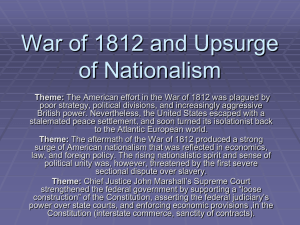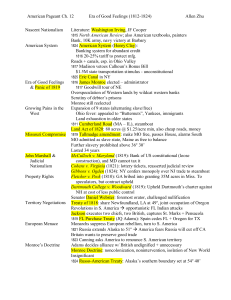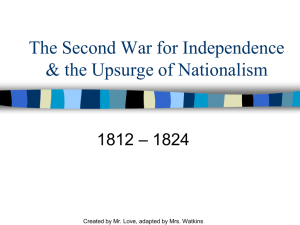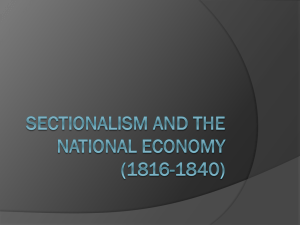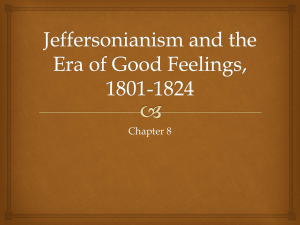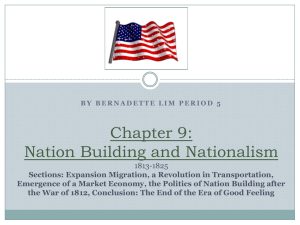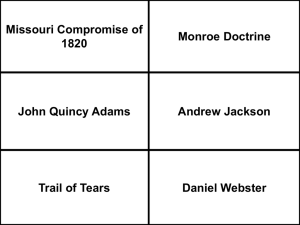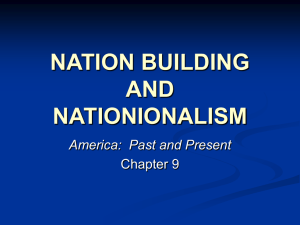War of 1812 and Nationalism
advertisement
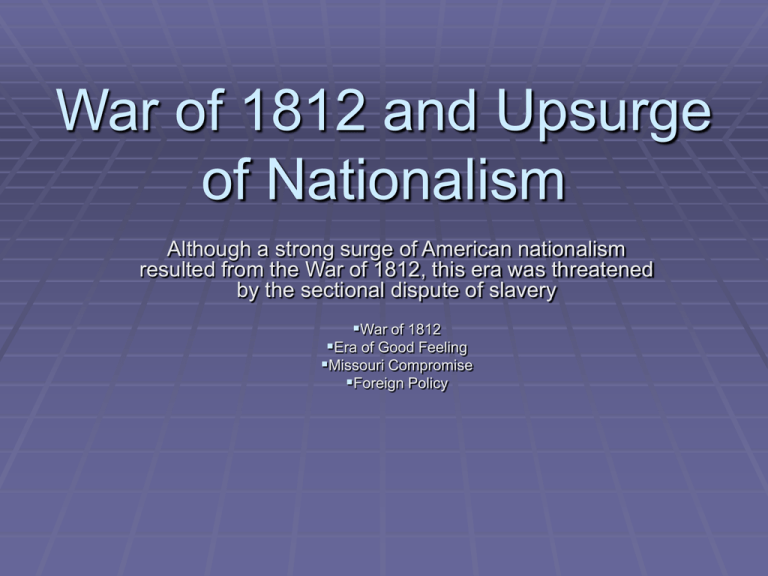
War of 1812 and Upsurge of Nationalism Although a strong surge of American nationalism resulted from the War of 1812, this era was threatened by the sectional dispute of slavery War of 1812 Era of Good Feeling Missouri Compromise Foreign Policy I. War of 1812 A. Characteristics 1. Canadian front a. Failed Canadian Invasions, 1812-1813 Constitution O. H. Perry 2. b. c. New York front a. Tom Macdonough at Plattsburgh 3. 4. 5. Chesapeake front a. Francis Scott Key New Orleans front a. Andrew Jackson b. Treaty of Ghent Federalist Front a. Hartford Convention b. sectionalism II. Era of Good Feelings A. Impact of the War 1. i B. Clay’s American System 1. 2. 3. James Monroe Revolutionary War Veteran C. D. Tariff of 1816 a. 20-25% (protective trend) b. Sectional debate 2nd BUS-Jeffersonians! Internal Improvements a. Calhoun’s Bill, 1817 b. Erie Canal, 1826 Election of Monroe, 1816 Panic of 1819 1. 2. E. Nascent Nationalism a. Decline of dependence GB b. Westward expansion c. Political optimism Overspeculation BUS v. “wildcat” banks Relection of Monroe, 1820 Era of Good Feeling? Issue Favor Oppose Tariff West North/South Internal improvements paid for by Feds West North/South BUS or “expensive $” North West/South Control the Indians and sale public lands West/South North Panic of 1819 Western hostility toward Northern Banks Slavery Increased sectionalism between North and South Growing West North West VT (1791) KY (1792) LA (1812) TE (1796) MS (1817) OH (1803) AL (1819) IN (1816) IL (1818) South III. Missouri Compromise A. Missouri Compromise 1. Issues: maintain sectional balance a. Tallmadge Amendment: no more slaves 2. 3. Provisions a. Maine free and Missouri slave b. 36’30’ Legacy of Compromise B. Marshall Court, 1801-1835 1. 2. 3. 4. Fletcher v. Peck (1810) Dartmouth College v. Woodward (1819) McCulloch v. Maryland (1819) Gibbons v. Ogden (1824) IV. Foreign Policy A. Treaties 1. Rush-Bagot Treaty, 1817 2. Treaty of 1818 3. Adams-Onis Treaty, 1819 B. Monroe Doctrine 1. Latin American Revolutions 2. Anglo-American Alliance 3. Message to Congress: Hands Off Europe! 4. Significance U.S., 1821 Treaty of 1818: 49th Treaty of 1818: Oregon Adams-Onis Treaty, 1819 •Spain cedes Fl to US •US out Spanish America •Spanish out of OR Treaty of 1818: fishing Rush-Bagot Treaty, 1817 Oliver Hazard Perry Thomas Macdonough William Henry Harrison Francis Scott Key Andrew Jackson Washington Irving James Fenimore Cooper John Marshall John C. Calhoun John Quincy Adams Daniel Webster Henry Clay Protective tariff Sectionalism Internal improvement Campaign against Canada Fort McHenry 2nd BUS McCulloch v. Maryland American System Gibbons v. Ogden Bonus Bill of 1817 Fletcher v. Peck VA Dynasty Dartmouth College v. Woodward Era of Good Feelings Treaty of 1818 Panic of 1819 Land Act of 1820 Monroe Doctrine and Tallmadge Amendment Missouri Compromise Russo-American Treaty, 1824 Treaty of Ghent Hartford Convention “Blue Light” Federalists
